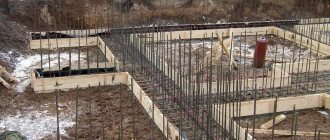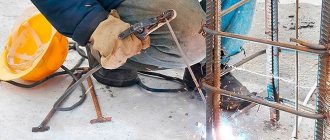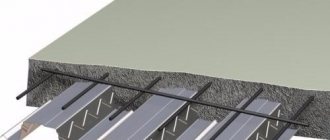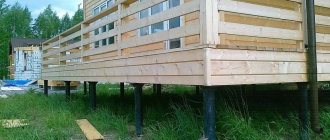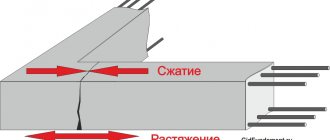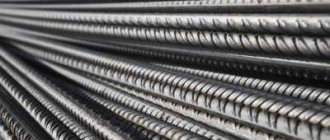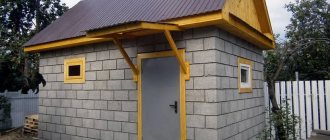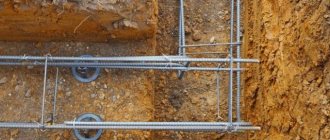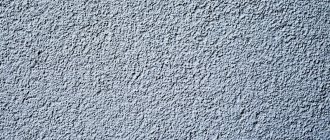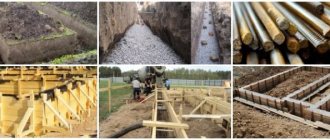When constructing buildings and premises of various types of functionality, one of the most important points of the work performed is the installation of a reliable foundation. If the load-bearing foundation is not made very well, not in accordance with existing norms and standards, any house will probably not last long - at least regular cracks and major repairs will be ensured. Therefore, the issue of strengthening the fundamental structure with the help of reinforcement is always very acute - special metal rods, the iron base of any reinforced concrete product. You can achieve the desired strength in two ways:
- viscous reinforcement elements using tying wire;
- welding reinforcing bars into a single fixed frame.
For professional builders, when the question arises whether to knit or weld, and whether it is possible to weld reinforcement for the foundation, each specific case is considered, and the decision is made individually, taking into account all the conditions involved.
By the way, construction experts have not yet come to a consensus on which reinforcement method is considered more preferable. Both knitting and welding of foundation reinforcement have their supporters.
Welding for foundation reinforcement
Pros and cons of welding work
Before choosing one of the methods of reinforcing the foundation for a building under construction, even at the design stage, you should consider the strengths and weaknesses of each of them. Among the advantages of welding for connecting reinforcing elements, one can immediately note their speed and the production of a more durable, indestructible frame. This method is the most optimal for the construction of large, large-scale objects, for example, industrial premises of various types. However, welding reinforcement for the foundation also has its disadvantages, which are discussed below.
- It is highly not recommended by experts to use a welded connection of reinforcement in areas with increased seismic activity, or on moving soils (which, by the way, also include loose soils). Soils that are too mobile will inevitably, over time, cause the foundation produced by this method to shrink. Because of it, rigid welded joints in the structure can break. In such conditions, it is recommended to use wire and a method of connecting reinforcement - knitting: it holds the frame together relatively movably and firmly, but allows the foundation elements to move within certain limits even with noticeable ground movements. This limitation significantly reduces the scope of welding when laying load-bearing structures of buildings.
- The welding process also affects the elements being connected. The fittings are exposed to very high temperatures. As a result, some destruction of the metal structure occurs in the places where welding work is carried out, which negatively affects the overall rigidity and strength of the frame itself.
Nevertheless, welding still remains the leading method of equipping foundations for large buildings.
Strengthening the foundation - what is it for?
A well-designed and high-quality foundation is a guarantee of the durability of the structure. A strong, indestructible base will prevent shrinkage, which causes cracks and subsequent destruction of the structure. Therefore, strengthening the foundation is a serious issue that cannot be treated superficially. Increasing the strength of the foundation is achieved by reinforcing the structure with metal mesh or rods of a certain diameter.
Should the reinforcement for the foundation be welded or knitted - this is the main question that many people think about
For low-rise buildings, a strip foundation is most often installed. You can save money and fill the foundation with regular concrete without additional reinforcement. Most likely, after some time, cracks and deformations will appear in the foundation. To prevent undesirable consequences, carry out reinforcement work with a steel frame that:
- Increases strength.
- Evenly distributes the load.
- Compensates for soil reactions during freezing.
- Will increase the service life of the structure.
Reinforcement in concrete will protect the foundation from cracking and destruction.
Reinforcement cage welding process
For large volumes of construction work, the elements are welded together in the factory. Briefly, this process looks like this.
Preparation of reinforcement
- Preparation of reinforcement; checking the quality of elements. At this stage, reinforcement blanks are selected that meet the standards and certain characteristics.
- Cleaning of workpieces. At this stage, not only dirt and dust are removed from the reinforcement, but also traces of corrosion, if any. And the material is processed accordingly.
- Marking and cutting elements in accordance with the building plan. Measurements are taken according to the design and the material is cut into the required quantity.
- A horizontal structure is assembled from rods and tacked by welding.
- Vertical elements are placed at the calculated distance; their perpendicularity to the frame frame is checked.
- The rods are once again verified for adequacy of the entire reinforcement structure.
Welded reinforcement
At the last stage, final welding work is carried out to finally connect the elements into the frame planned by the project.
Welding process
What is fittings needed for?
To compensate for tensile loads that are dangerous for concrete, a special reinforcing structure is placed inside its “body” - a reinforcing frame. During installation, it is given the shape of a lattice, positioned in such a way as to absorb tensile stresses. The simplest version of this design is several reinforcing bars connected to each other and placed inside the formwork before pouring concrete.
In more complex cases (when it is necessary to strengthen the foundation as much as possible), the frame is assembled from a combination of main and auxiliary rods. The first ones are made from thicker blanks and are placed longitudinally.
Auxiliary rods are needed only to support the longitudinal bars and are required only when pouring.
The main load after the mixture hardens (during operation of the foundation) falls on the working rods. The auxiliary ones remain inside the array, since they cannot be removed from the frozen structure.
The reinforcing frame is assembled directly on the working site from individual rods, pre-cut to length. They are connected by means of soft annealed wire, which secures the lattice nodes with twists. At first glance, it seems that welding reinforcement is much easier and faster than making twists from wire. In order to say this with confidence, you will first have to take a closer look at how the reinforcing belt and its individual elements “work.”
Connecting reinforcement elements
This process can be carried out in several ways:
- end-to-end;
- overlap;
- crosswise;
- in a T-shaped manner.
Taurus and end-to-end are considered not very desirable. In both cases, the elements are connected at right angles, which means that the final product will show insufficient bending strength. However, such connections are still sometimes used if it is not possible to avoid such a connection for some objective reason. Usually, the length of the reinforcement is welded with an overlap, and the crossbars are fixed with a cross. Although, we note that, for example, American standards do not recognize cross intersections in the construction of foundations.
Before carrying out work on the frame, test welding must be carried out. Two small rods are taken for it; the elements are connected, and after cooling the seam is examined for quality. The appearance of cracks, the state of the resulting slag, and the depth of penetration of the reinforcement body are monitored. If at least one of the parameters does not seem to meet the standards and conditions, the current strength in the welding machine is adjusted or the electrodes are changed.
How to weld reinforcement
Features of the “work” of reinforcement in concrete
Upon closer examination of the surface of the reinforcement bars, its corrugated structure is clearly visible. This device guarantees reliable adhesion of the rods to the hardened concrete and allows you to easily keep them in a fixed state. Under the action of multidirectional loads, the main forces are taken by the corrugated rods. At the same time, the concrete is unloaded and better preserved, which eliminates the possibility of cracks or fractures appearing in it.
Since auxiliary elements do not participate in the distribution of loads - they have a smaller thickness, and their surface is made smooth (without corrugation), class A1 (A240) reinforcement is used for these purposes.
Reliable connection of the components of the reinforcing frame is necessary to withstand loads only at the moment of pouring the liquid mixture. This is explained by the heavy weight of the concrete composition, which under certain conditions can destroy a not very strong fastening.
Possible welding problems
These types of problems occur most often.
- Electrode sticking. The current is insufficient, it should be increased.
- Burning a surface without sticking to it. The current is too high and needs to be reduced.
- Difficulties with “catching” the arc, the rod is burned through. An electrode with a smaller cross-section is required.
- Foaming of slag, burning of the electrode with a “visor”. The electrode is defective or on the verge of wear. To be replaced.
The welding technology itself is not too complicated; if necessary, work on constructing a frame for the supporting structure can be carried out directly on the construction site. If the construction volumes are small, often the workers constructing the foundation do just that.
Welding for stable soils
The need to reinforce the load-bearing base
The durability of a residential building or other structure is guaranteed by a foundation built in accordance with all technical requirements using the correct technology for performing the work.
And if during the construction of such an important and main building structure as a load-bearing foundation, gross technological and technical errors were made, shrinkage deformations and cracks may appear on the load-bearing structures. The strength of the load-bearing base can be increased by reinforcing it with a metal spatial frame or reinforcing mesh.
Reinforcement products in solid concrete will reliably protect the monolithic foundation from the appearance of cracks and reliably protect it from possible destruction.
Minimizing negative impacts
It is clear that natural factors cannot be overcome (at least in most cases). However, it is considered quite possible to reduce the negative impact of welding on metal in construction work. Experts have developed a whole range of measures aimed at minimizing losses during welding operations.
- Selection of reinforcement for the frame. It is strongly recommended to use rods classified as A400C or A500C. Their diameter and carbon content in the metal are optimal for equipping the supporting structure by welding.
- Selection of electrodes. They must correspond to the diameter of the elements assembled into the frame. If relatively thin rods are to be used, most commercially available electrodes will suffice. If the reinforcement frame is constructed from elements with a diameter greater than 14 mm, you will have to stock up on specialized electrodes for these cases. Moreover, it is advisable to purchase those that are designed to work with low-carbon steel. Such electrodes have a less intense impact on the metal during welding and will provide a structure with greater strength.
- Welding machine. For welding reinforcement for the foundation, when connecting reinforcing elements, it is recommended to use equipment with continuously variable control of the supplied current. Insufficient current will not make it possible to achieve a reliable, durable and high-quality seam, which can subsequently lead to subsidence of the foundation, or even to the destruction of the building as a whole. An excessively intense current will overheat the metal, and the reinforcing element will become brittle after cooling.
Need a welding machine
- In order for the welded joint to be as strong as possible, it is necessary to press the welded elements together as tightly as possible. However, this is quite difficult to do. Some craftsmen advise using a grinding tool. The rods are cleaned to relative smoothness, and the connection area of the reinforcement increases.
And finally, there are recommendations in construction work for treating seams with anti-corrosion compounds. At the point of welding, the metal becomes more vulnerable to moisture, and the solution from which the foundation is poured contains plenty of it and takes a long time to dry.
Subtleties of welding work
To completely dispel the myth of why you can’t weld reinforcement in the foundation, you need to know the specifics of performing all the actions.
Initially, reinforcement of the required diameter and length is prepared, corresponding to the design specifications for the arrangement of the foundation frame. After this, the following algorithm of actions follows:
- purchased material is checked for quality;
- Rejection is carried out, during which metal blanks are identified whose characteristics do not meet the requirements of regulatory documents;
- steel rods are cleaned of corrosion, straightened, coated with an abrasive compound, and cut into blanks of the required sizes;
- all elements of the future frame structure are connected in a common plane using light tack welding units, final fixation is carried out later;
- blanks for the future frame part are fixed with special jigs at distances determined by the design drawings;
- the structures are tacked by welding, the compliance of the frame parameters with the data in the design documentation is specified;
- The final working stage is the final welding of the frame.
When following the technological stages of welding reinforcing bars at a construction site, remember that it is better to use a special unit for inverter welding.
The main indicators of the modes during operation of the welding machine are:
- electrode cross section;
- the magnitude of the type and polarity of the electric current;
- electric arc voltage indicator;
- speed of welding work;
- number of approaches.
When using the contact welding method and determining its operating parameter, the main indicator is the strength of the current used, on which the quality characteristics of the resulting weld and the work productivity indicator completely depend.
The choice of electrode diameter is made taking into account the thickness of the metal being connected. It must be remembered that the operating mode is based on the level of electrical current. When the electrode used is thicker than four millimeters, it is recommended to reduce the standard current by ten to fifteen percent. When deciding on the polarity mode, give preference to reverse. Due to the fact that when working on a constant electric current, thermal energy is actively generated, the likelihood that burns will appear in the metal material increases.
The latest welding units can convert alternating electric current, and after switching on the appropriate mode, the electric current supplied to the electrode rod turns into direct current.
When choosing a speed mode, make sure that the bath filled with hot steel is located above the surface of the edges. It is best to select a mode in which the width of the welding seam is one and a half to two times the diameter of the electrode rod.
Having assembled the reinforcement structure intended for the foundation, it is necessary to carry out a simple test. A board is laid on the surface of the frame, on which a person begins to walk. If the frame system is assembled according to the design drawings, it will not bend due to weight.
Before starting to supply the concrete mixture, the reinforcement system is further strengthened in order to be securely fixed in the foundation body.
Knitting method
Knitting is carried out using a specialized wire that connects the reinforcement bars to each other in the corners of the foundation structures. Knitting is quite easy to do if you know the basic principles of the work.
Knitting method
When the foundation has already been built, it may still sag in the ground for some time. This is due to the large mass of the entire structure. In this case, the knitting will give the foundation reinforcement being connected some freedom, the connections will remain in their proper places (they will not break, as is the case with welding, if the level of soil subsidence in the place chosen for construction is high enough). We can safely talk about using this method of knitting reinforcement even on the most difficult soils. The welding will not withstand the loads and will crack. This will not happen during mating. All connections in the foundation remain more or less movable. And this nuance does not entail the appearance of additional stress in the foundation structure.
Knitting is used on difficult ground
The simplicity and convenience of the knitting process is that everything is done directly on site (for large structures, sometimes in a workshop). Simple tools are used, which (unlike welding) can be handled even by a less experienced builder. Most often, this is a special kind of hook; it allows you to connect several parts of the reinforcement to each other. The operation of the connection will require minimal costs - the effort of one worker is enough. When using this method, the strength of the entire structure will not decrease, and the structure of the metal will be preserved. Rigidity with reinforcement strength is at the proper level.
By the way, you can also acquire special tools for the job. Today, tying guns are widely available. The design is quite simple, and the cost is not too high, so you can afford it. In addition, the cost of work is reduced as a result. But you can also use an ordinary crochet hook.
Knitting technologies
What is pool welding?
Bath welding of reinforcement is the most reliable method of connecting individual sections of metal structures made of high-strength alloy steel. ... When carrying out conventional butt welding, the quality of the seam will be unreliable, the connection will break near the seam.
Interesting materials:
What metro station is near Leningradsky Station? What is the article for insulting nationality? What is the penalty for filming without permission? What is the element of the zodiac sign of Leo? Which side of the horizon is opposite southwest? What is the relationship between vector coordinates and point coordinates? What bond is formed between nonmetal atoms with the same EO? What is the bond in a sulfur molecule? What temperature should it be for the dough to rise? What temperature should it be to turn on the heating?
Boil or knit? That is the question…
Based on the above, we draw conclusions about: which methods are better to use in private construction - bonding or welding? Undoubtedly, each of the discussed methods is famous for its advantages, but there are also disadvantages. Welding proceeds at maximum speed, and knitting is a rather lengthy process, although it does not require a special apparatus. It is best used in the construction of private houses, cottages, outbuildings, and baths. It is in these cases that the method is most effective.
And when constructing buildings with large dimensions, attention turns to welding. Rods are used that have a diameter of more than . Therefore, connections using wire will present certain difficulties. Welding in this case will be the most correct solution.
However, the disadvantages of the welding method technology do not make it possible to use it on so-called difficult soils (and swampy areas practically exclude this method). After all, if a connection is used by welding, it will not withstand the external stresses that arise during shrinkage, which will lead to a loss of integrity of the structures and a loss of their rigidity. Tying technologies will ensure the most flexible connection of reinforcement on difficult soils. Here the rods, depending on the condition of the soil, will be able to move spatially without causing damage to the entire structure.
Video about methods of connecting reinforcement using various methods:
How to tie a frame for placement in the foundation
When planning to manufacture a reinforcing grid using the tying method, purchase the required materials and prepare the tools in a timely manner.
Knitting technology is easy to master on your own, following the recommendations given:
- Place the horizontal elements of the lower tier at a fixed distance from the soil level. You can ensure the required gap of 40–60 mm using plastic supports, wooden pads or waste bricks. The frame rods should not touch the ground.
- Ensure that vertical bars are installed at equal intervals between them. Maintaining a constant step will allow you to evenly distribute the load. It is important to protect the elements from contact with the soil using special supports made of non-metallic material.
- Fix the spatial frame reinforcement with binding wire. When performing work, check the reliability of fastening in the connection areas. The elements should not move when pouring concrete into the formwork.
If you have at least a little experience in the field of construction, knitting reinforcement is quite simple
- Maintain equal spacing between the reinforcement located in the horizontal tier, as well as between the vertical elements. It is important to additionally secure the corner reinforcement, which is prone to displacement during the concrete pouring process. The corner parts should not protrude beyond the contour of the base.
- Check the strength of the assembled frame under load. Place a wooden board on the top belt of the metal structure and stand on it. When moving along the board, the frame elements must remain motionless.
Additional fixation of the frame placed in the formwork using wooden blocks will ensure its immobility when filling the formwork with concrete mortar. When purchasing materials for the manufacture of power grids, comply with the documentation requirements for the use of fittings of the required brands and assortment.
We call on modern technologies to help
The modern construction equipment market offers a huge range of tools that allow you to quickly and easily cope with the most complex work that takes a lot of effort and time. Of course, these rules also apply to knitting reinforcement. Therefore, if you wish, today you can buy or rent a special gun for tying reinforcement.
Tying reinforcement with a special gun
With its help, any amount of work can be completed in a matter of minutes. The process is completely mechanized, and a person can only enjoy a job well done. The gun, a bit like a drill, is simply brought to the crossed fittings, after which the “trigger” is pulled. Less than a second passes, and a wire appears in the right place, reliably tightening and fixing the reinforcement.
After a few minutes of work, having mastered the gun for tying reinforcement, you will be able to produce up to 40-50 ties. Even if you need a frame for a huge monolithic foundation, the work will take a little time.
It is important that the modern market offers a large selection of pistols. They differ in the speed of knitting, the thickness of the wire used and the number of skeins of wire when knitting.
This means that you yourself can choose the model that suits you in terms of efficiency and speed of work. Unfortunately, there are certain disadvantages here too. To begin with, when working with a gun, it is recommended to use only special wire suitable for this type of gun.
Checking the strength of the connection
If you want to make sure that all negative impacts from welding are minimized, you can conduct an experiment that will show the result of the work and the quality of the connection. To do this, two metal rods are taken, welded together, and then they cool. When the joint temperature has returned to room temperature, you can look at the welding site and evaluate its quality. If cracks appear in the connection area, it means that the technology or construction material for installing and installing the foundation of the future building was incorrectly selected. When the connection is without cracks or deformations and is strong, this means that all stages of the work have been completed correctly and the selected metal is suitable for further work. Now, after checking the strength of an individual element, you can make your choice.
